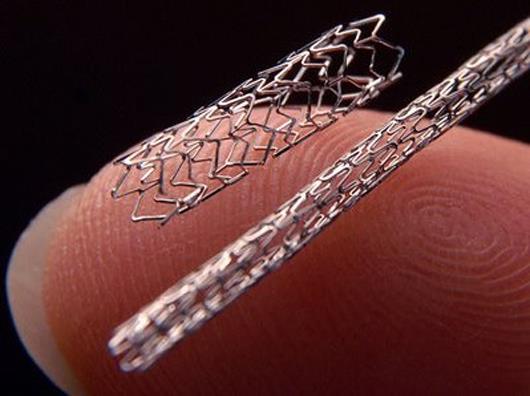Drug Eluting v. Bare Metal Stents

Editor’s Note:
Please review a previous article related to this issue as well- Heart Surgery for the Poor?
The Golden Goose
Cardiologists once thought that drug-eluting stents (DES) were the greatest advance in the treatment of coronary artery disease CAD since the advent of bypass surgery. Using DES, studies showed, significantly reduced the problem of restenosis – re-occlusion (reclogging) of the coronary artery – that was often seen with bare-metal stents. But today it is quite apparent that using DES presents its own, unique problem with restenosis, a problem that may be as (or more) significant than the restenosis seen with bare metal stents. Namely, if you prematurely discontinue your antiplatelet drug therapy after receiving a DES, you are significantly increasing your risk of sudden occlusion of the artery, which could lead to heart attack or death.
The Problem of Restenosis
Following placement of a bare-metal stent, restenosis can occur when abnormal cells grow within the stent. Since these cells accumulate over time, symptoms caused by slowing of the blood flow through the stent tend to occur slowly, as opposed to suddenly. DES — which are stents coated with drugs that inhibit cell growth — were developed specifically to address this “typical” kind of restenosis. And indeed, DES proved remarkably effective in preventing this restenosis, which led to their widespread adoption by cardiologists.
Unfortunately, a few years ago it became apparent that a different kind of restenosis could occur with DES. This restenosis appears to be caused by the sudden formation of a blood clot within the stent, causing rapid occlusion of the artery. This can lead to a sudden, total blockage of the artery, leading to an acute myocardial infarction (heart attack) or even sudden death.
Why does this happen? Apparently, while DES successfully inhibits cell growth within the stent, this inhibition of cell growth leaves the surface of the stent itself directly exposed to the blood flow for a very long period of time – months or years. And when blood comes in direct contact with the surface of the stent, the clotting mechanism can be engaged, which can lead to thrombosis within the artery.
Preventing DES-Related Thrombosis
The risk of sudden thrombosis within a DES is significantly reduced with the use of antiplatelet drugs like Plavix (clipidogrel), usually in combination with aspirin. Originally it was thought that using Plavix and aspirin for a few months would be sufficient, but now it appears that they need to be continued for at least a year – and possibly indefinitely. (Ongoing studies are attempting to define just how long antiplatelet therapy needs to be continued.)
Why Stopping Plavix Is a Bad Idea
Once the problem of sudden occlusion of DES came to light, cardiologists began to notice that some of their patients who stopped Plavix, even for a few days (say, in preparation for elective surgery), experienced particularly dangerous forms acute coronary syndrome (ACS), which were often fatal. But the actual incidence of ACS when Plavix is prematurely discontinued (and again, we still do not really know what constitutes “prematurely”), has been difficult to ascertain.
However, a recent report appearing in the American Journal of Cardiology suggests that stopping Plavix is more dangerous than previously realized. This study followed more than 1,300 consecutive patients who successfully received DES and were sent home on Plavix and aspirin. Nearly 10% of these patients discontinued antiplatelet therapy, for one reason or another, during the first 12 months – and nearly 29% of these patients experienced stent thrombosis or death, a risk which was double that experienced by patients who continued their antiplatelet therapy.
So, while DES does present a significant advantage over bare-metal stents (i.e., the reduction in “typical” restenosis due to cell growth), it does so at a big price. Specifically, anyone who receives a DES is obligated to remain on Plavix (or similar drugs) for a prolonged period of time. Because of the propensity for excessive bleeding that accompanies the use of these drugs, this requirement makes it very difficult if one needs to have a surgical procedure of any kind, or experiences significant trauma.
Practically speaking, the most common dilemma faced by patients with DES occurs if they require an operation, say, gallbladder surgery. The surgeon absolutely refuses to operate while the patient is on Plavix, and the cardiologist absolutely refuses to permit the patient to discontinue Plavix for the surgery. The patient is stuck with no good answer, and no good course of action.
What’s the Answer? What Should You Do?
As is the case with so much of medicine, if you need a stent there is no perfect option for you – only trade-offs. At the very least, your cardiologist absolutely owes you a frank discussion of the pros and cons of stent therapy vs. non-stent therapy, and if a stent is the best answer, of the pros and cons of DES. He or she should be able to give you a direct answer to the question, “What if I need surgery in the next year or so?” If you don’t get this frank and thorough discussion from your cardiologist, you should consider getting a second opinion.
As time goes by, more and more surgeons are learning techniques to deal successfully with patients taking Plavix, and vigorous efforts are being made to develop new kinds of stents that will not have this problem with sudden thrombosis. But in the meantime, before you decide on the best therapy for your CAD, it is critical that you understand the potential risks and the benefits of all the treatment options open to you.
References
The Restenosis Problem With Drug-Eluting Stents (DES)
Don’t Stop That Plavix
Updated November 13, 2011
Reviewed by a board-certified health professional.

